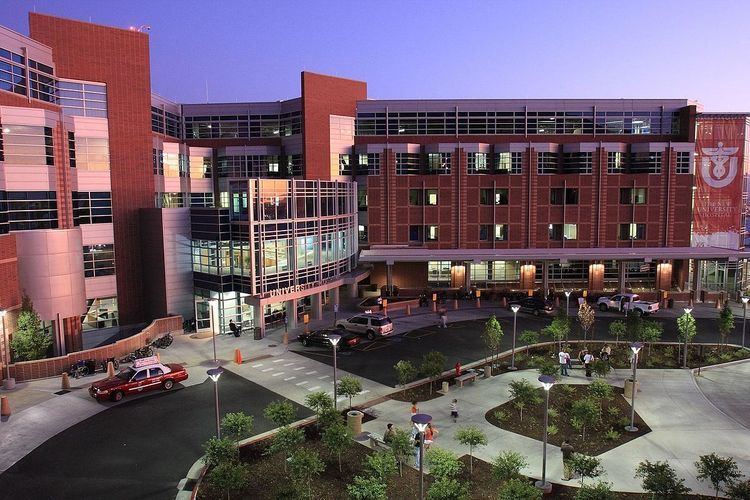The University of Utah School of Medicine is located on the upper campus of the University of Utah in Salt Lake City, Utah. It was founded in 1905 and is currently the only medical school in the state of Utah.
The school began in 1905 when the Biology department offered a two-year medical course. The founding dean was Dr. Ralph Vary Chamberlin. In 1912, the medical program was established as a separate two-year medical school and became a member of both the Association of American Medical Colleges and the American Medical Association. For the next 30 years, it continued as a two-year program; students were required to complete their final two years of training at other medical schools. The board of regents approved a four-year medical school in 1942.
In the 1950s and 1960s, the University of Utah School of Medicine emerged as a prominent center for bio-medical research, thanks to the work of pioneering physicians and scientists such as Maxwell Wintrobe, Louis Goodman, Homer R. Warner, and Willem Kolff. To this day, the school maintains a reputation for strong scientific investigation, especially in fields such as genetics and bio-medical informatics.
Medical education expanded significantly in 1977, when the University of Utah formed a partnership with Primary Children's Hospital, thus providing the medical school with a dedicated facility for teaching and research in pediatrics. The medical center has expanded even more in recent years, with the creation of the Huntsman Cancer Institute in 1995 and the expansion of the Moran Eye Center in 2006. Such developments have provided even greater learning opportunities for medical students, residents, and fellows at the school.
In 2007, Mario Capecchi, distinguished professor of human genetics and biology, was award the Nobel Prize in Physiology or Medicine for his method of introducing homologous recombination in mice by way of embryonic stem cells.
The School of Medicine is divided into the following departments: Anesthesiology, Biochemistry, Biomedical Informatics, Dermatology, Family & Preventive Medicine, Human Genetics, Internal Medicine, Neurobiology and Anatomy, Neurology, Neurosurgery, Obstetrics & Gynecology, Oncological Sciences, Ophthalmology and Visual Sciences, Orthopaedics, Pathology, Pediatrics, Physical Medicine & Rehabilitation, Physiology, Psychiatry, Radiation Oncology, Radiology, and Surgery.
Centers and Institutes
The Brain InstituteHuntsman Cancer InstituteMoran Eye CenterNeuropsychiatric InstituteOrthopaedic CenterPrimary Children's Medical Center (affiliated)William DeVries - renowned cardiothoracic surgeon, performed the first successful permanent artificial heart implantBrent C. James - internationally known expert in clinical quality improvement, featured on the cover of New York Times Magazine in November 2009Robert Jarvik - medical scientist, inventor of the artificial heartRobert Metcalf - educator and pioneer in arthroscopic surgery and sports medicineRussell M. Nelson - renowned cardiothoracic surgeon, prominent leader in The Church of Jesus Christ of Latter-day Saints (LDS Church)Dale G. Renlund - cardiologist and member of the Quorum of the Twelve Apostles of the LDS ChurchCecil O. Samuelson - physician and administrator, former president of Brigham Young UniversityBalamurali Ambati - ophthalmology educator and researcher, became the world's youngest doctor at age 17Mario Capecchi - molecular geneticist, winner of 2007 Nobel Prize in Physiology or MedicineRalph Vary Chamberlin - biologist, historian, and pioneering ethnographer; served as first dean of the medical school from 1905 to 1907Louis S. Goodman - chemotherapy pioneer, co-author of Goodman & Gilman's The Pharmacological Basis of TherapeuticsEdward I. Hashimoto - popular professor of human anatomy from 1935 to 1987; longest-tenured professor in the history of the University of Utah (52 years)Willem Johan Kolff - physician and scientist, prominent researcher in hemodialysis and artificial organsAnne G. Osborn - author, educator, and physician; well-known nationally as a leader in the field of neuro-radiologyChase N. Peterson - administrator, educator, and expert in endocrinology and renal disease; president of the University of Utah from 1983 to 1991Geoffrey Tabin - professor of ophthalmology; also a noted adventurer and humanitarian; co-founder of the Himalayan Cataract ProjectHomer R. Warner - pioneer in the field of biomedical informaticsMaxwell Wintrobe - physician and researcher, expert in the field of hematologyThe field of biomedical informatics was developed at the University of Utah. The Department of Biomedical Informatics was created in 1964 - the first in the nation - and today remains one of the most renowned programs of its kind in the world.In 1970, the university's hospital established the first cerebrovascular disease unit in the U.S. west of the Mississippi River.On December 1, 1982, the first artificial heart implant was performed at the University of Utah (by Dr. DeVries, mentioned above). The patient, retired dentist Barney Clark, had suffered from congestive heart failure. He survived for 112 days after the procedure. The implanted device was designed by Robert Jarvik (also mentioned above), who was a medical student at the U of U at the time.Utah is known throughout the world as a leader in the study of human genetics. The school has been involved in some of the most valuable research in field, such as the sequencing of the tumor suppressor genes responsible for breast cancer in the 1990s.WebPath, the world's most popular pathology education website, was created in 1994 by Edward C. Klatt, a professor in the Department of Pathology at the time.Advanced Wilderness Life Support (AWLS) is a certification course created at the University of Utah in 1997. AWLS is the gold standard program - both nationally and internationally - for teaching management of medical emergencies in wilderness situations.The John A. Moran Eye Center annually ranks among national leaders in research grants from the National Institutes of Health.From 2000 to 2010, the residency training program in diagnostic radiology has been ranked #1 in the world by the American Board of Radiology.
